
Solar Eclipse 2024
On April 8, 2024, residents and visitors to Niagara Region will find themselves in the direct path of totality during a historic total eclipse of the sun. This spectacular event will last for almost four minutes, starting at 2:04 p.m. and ending at 4:33 p.m., with totality occurring at 3:18 p.m.
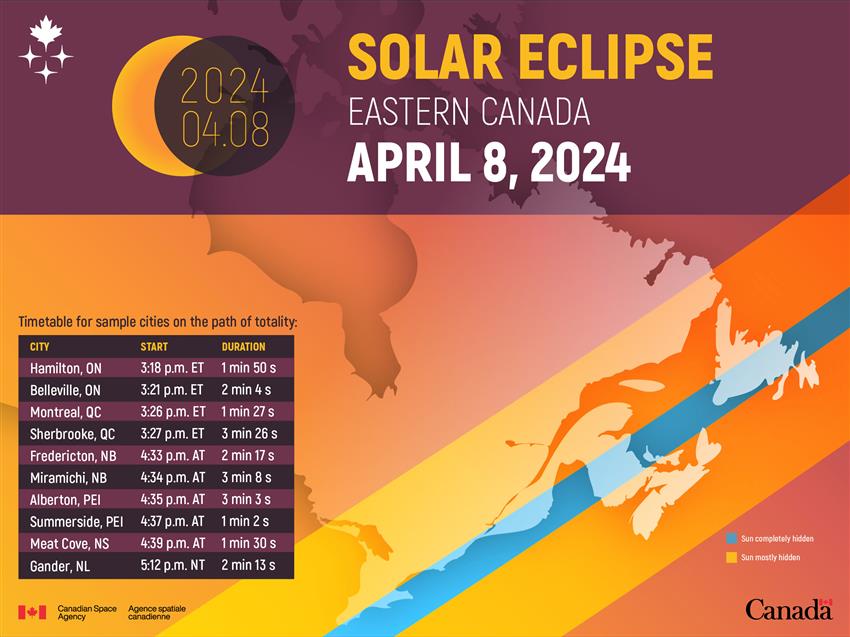
What is a Solar Eclipse?
A total solar eclipse happens when the Moon passes between the Sun and Earth, completely blocking the face of the Sun. People viewing the eclipse from locations where the Moon’s shadow completely covers the Sun – known as the path of totality – will experience a total solar eclipse. The sky will become dark, as if it were dawn or dusk. Weather permitting, people along the path of totality will see the Sun’s corona, or outer atmosphere, which is usually obscured by the bright face of the Sun.
What you can see during a total solar eclipse depends on the weather and the location from which you view it. You need clear skies to have the full eclipse experience, with a clear view of the Sun and Moon. However, the eerie daytime darkness associated with an eclipse is still noticeable with cloud cover.
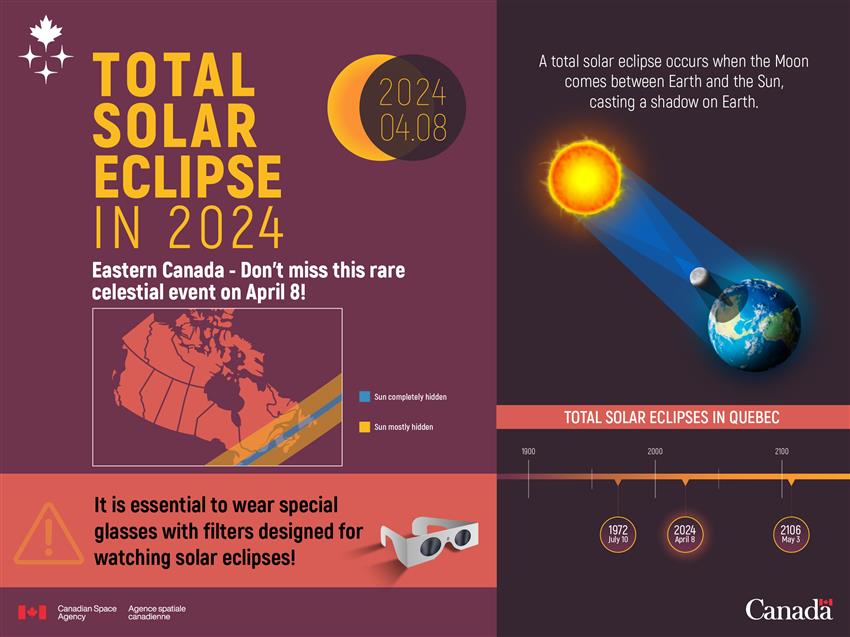
| How to avoid eye injuries. |
|
It is very dangerous to look directly at the sun at any time, but during an eclipse the temptation to have a quick glance can be very strong. To avoid damaging your retinas when viewing the solar eclipse:
What to avoid
|
For more information visit the Region of Niagara website LINK
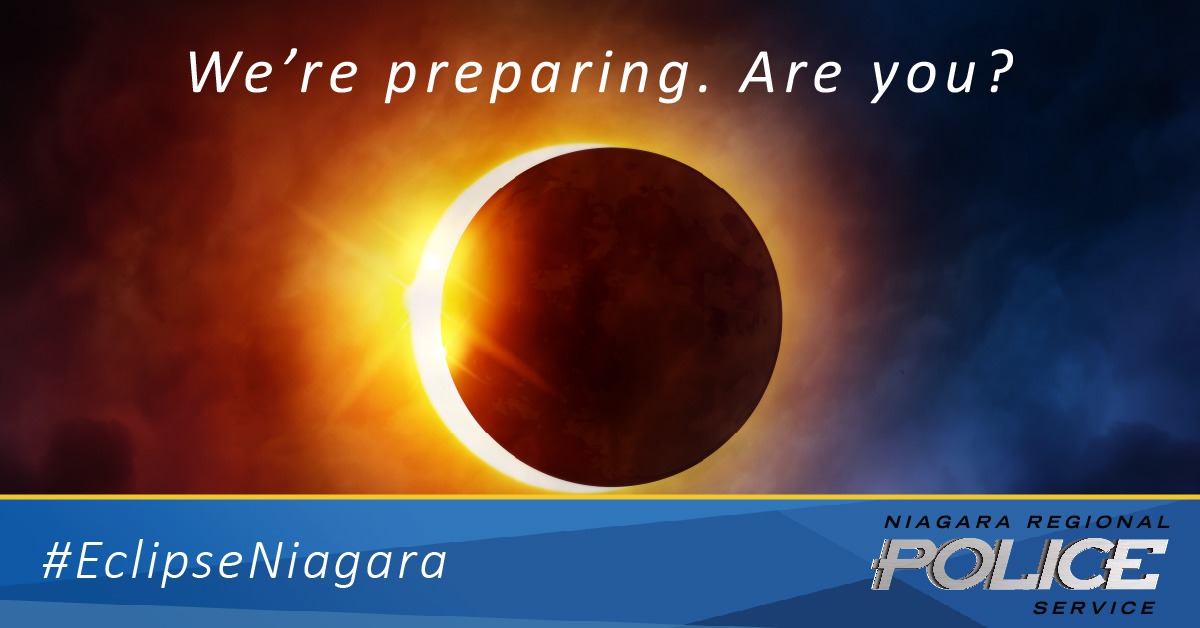
Traffic Congestion
Solar Eclipses are an infrequent act of nature. A solar eclipse that occurred on August 21, 2017, affected 14 states across the Unites States of America. This event saw millions of people traveling to areas in the Unites States that were part of the path of totality. The path of totality covered 16% of the United States. The millions of travelers resulted in significant traffic congestion and gridlock.
The Monday April 8, 2024, solar eclipse path of totality will pass through the City of Niagara Falls, and Port Colborne, and the Town of Fort Erie, and other Ontario cities. With Niagara Falls being one of Canada’s top tourism destinations it is anticipated that people from across Ontario, Canada, the United States may travel to the Niagara area. 98% of Niagara's 14,000+ hotel rooms are presently booked.
Traffic congestion is anticipated to be begin in the Niagara area Friday April 5, 2024, and build until the time of the eclipse. Following the eclipse, congestion may continue as visitors attempt to the leave Niagara. The congestion will affect many local Niagara roads and provincial highways.

| Tips to Mitigate Traffic Congestion |
|
Emergency Preparedness
Emergency preparedness is the proactive process of planning and organizing resources to effectively respond to, and mitigate, the impact of potential emergencies. Visitors and residents of Niagara should be preparing for the possibility that large crowds could impact traffic movement and access to supplies.
Visitors should be prepared and have a full gas tank, extra water, and food. While there are numerous public restrooms in Niagara, visitors stuck in traffic gridlock may not be able to access one nearby. Public urination and defecation are illegal. Visitors are encouraged to plan accordingly.
Local residents are asked to also plan ahead (48-72 hours in advance) by ensuring all of their vehicles are fueled up and having extra household supplies. In being prepared, residents will be able to limit their need to travel to areas congested by traffic.
|
Preparing for a solar eclipse involves ensuring safety and maximizing the experience. Here are ten emergency preparedness tips: |
By following these emergency preparedness tips, you can safely enjoy the awe-inspiring experience of a solar eclipse while minimizing potential risks. |
Solar Eclipse Niagara – Road Closures – Niagara Falls and Fort Erie
Planning for the April 8, 2024, solar eclipse remains ongoing in the Niagara Region to have a safe and enjoyable event. To allow for the safety of pedestrians, traffic management, and the movement of emergency vehicles there will be planned road closures in the City of Niagara Falls and the Town of Fort Erie.
The closures will allow access for local traffic, employment, emergency vehicles and to obtain some services (e.g., hospital). Motorists may experience short stoppages at the controlled barriers.
Unplanned road closures may occur due to the ongong operational assesements of the events.
Niagara Falls
City of Niagara Falls Road Closures – Access for emergency vehicles/local traffic/employment – 11am Monday April 8, 2024
- Morrison Street will be closed between Portage Road and River Road
- McCrae Street will be closed between Stanley Avenue and Victoria Avenue
- North Street between Main Street and Buchanan Avenue
- River Road between Morrison Street and Hiram Street
- Portage Road Between Dunn Street and McLeod Road
Niagara Parks Police / Niagara Regional Police Service Road Closures for eclipse crowd management – as needed or at 12pm Monday April 8, 2024
- River Road between Hiram Street and Fraser Hill
- Clifton Hill between Victoria Avenue and River Road
- Murray Hill between Fallsview Boulevard and River Road
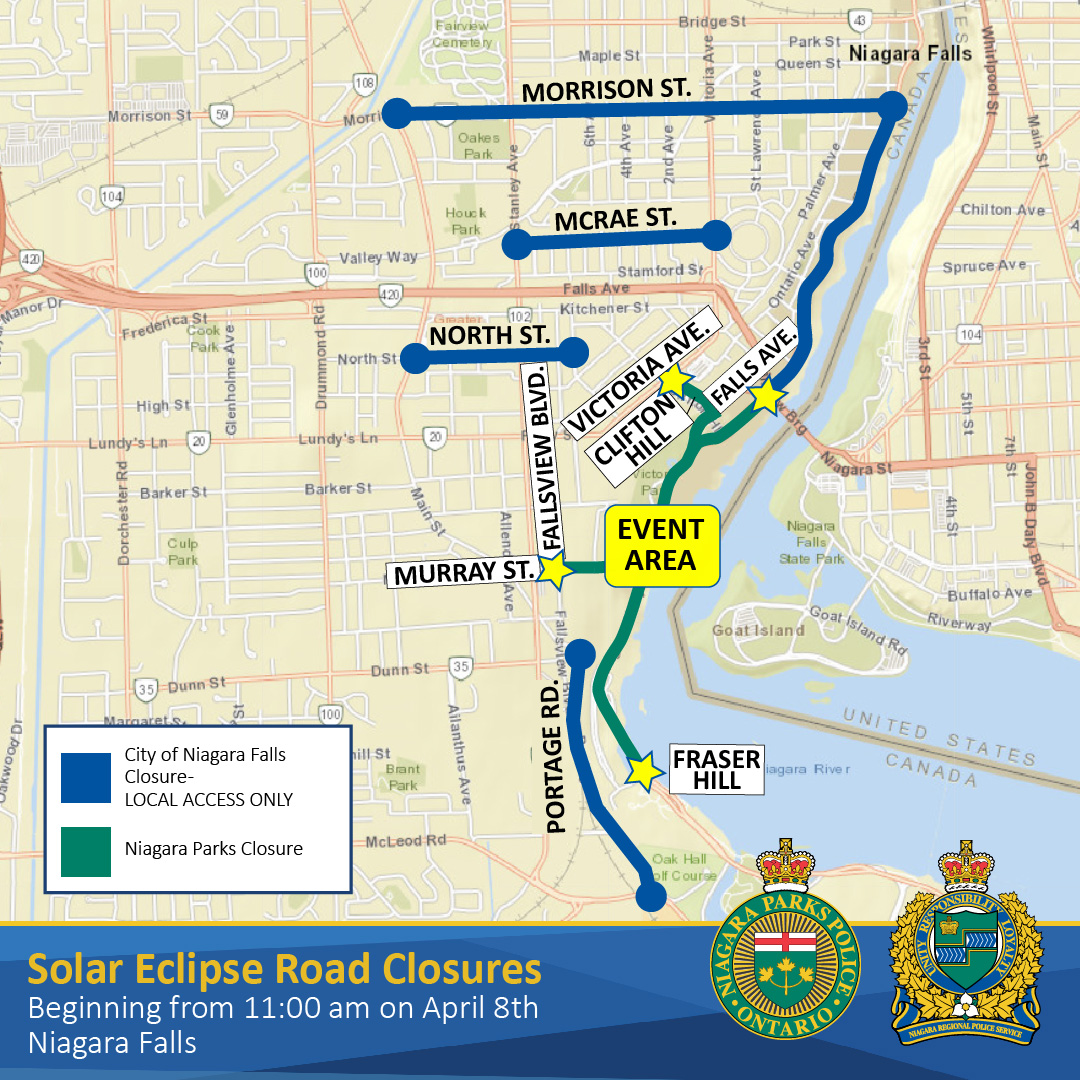
Fort Erie
Fort Erie Road Closures – Access for emergency vehicles/local traffic/employment - Monday April 8, 2024
Town of Fort Erie Road Closures
- Point Abino Road South at Erie Road (8:00am – 6:00pm)
- Crystal Beach Waterfront Park. Ridgeway Road will be closed at Crystal Beach Drive (before the Millington Skyway) and closed at Crystal Beach Drive and Lake Avenue intersection. (8:00am – 6:00pm)
- Derby Road between Erie Road and Cambridge Road East (12:00pm – 6:00pm)
Niagara Parks Police / Niagara Regional Police Service Road Closures for eclipse traffic / crowd management - April 8, 2024 (8:00am – 6:00pm)
- Mathers Arch Circle
- Lakeshore Road between Central Avenue and Dominion Road
- Lakeshore Road between Dominion Road and Adelaide Street
- Dominion Road between Adelaide Street and Lakeshore Road
- Adelaide Street between Lake Shore Road and Dominion Road
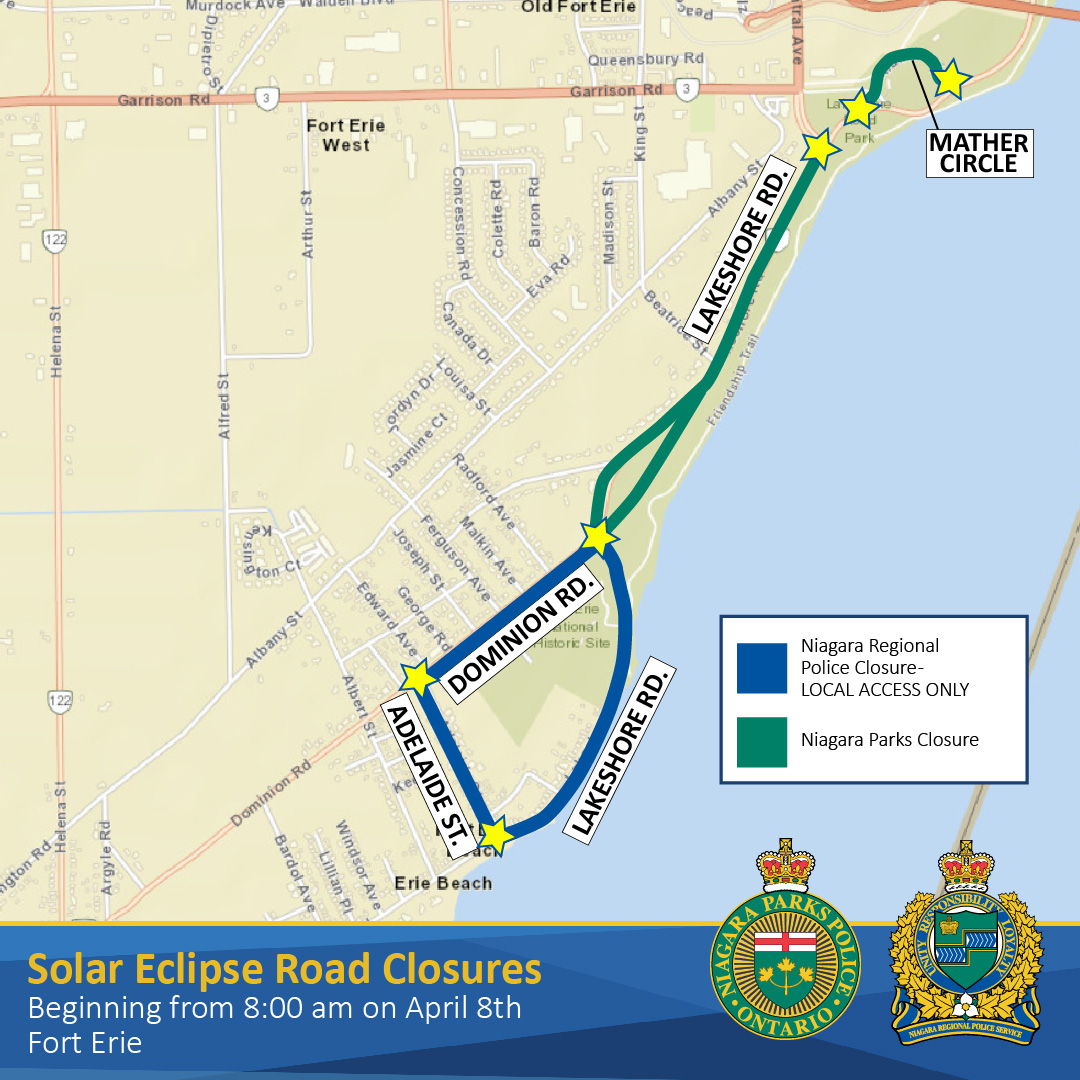
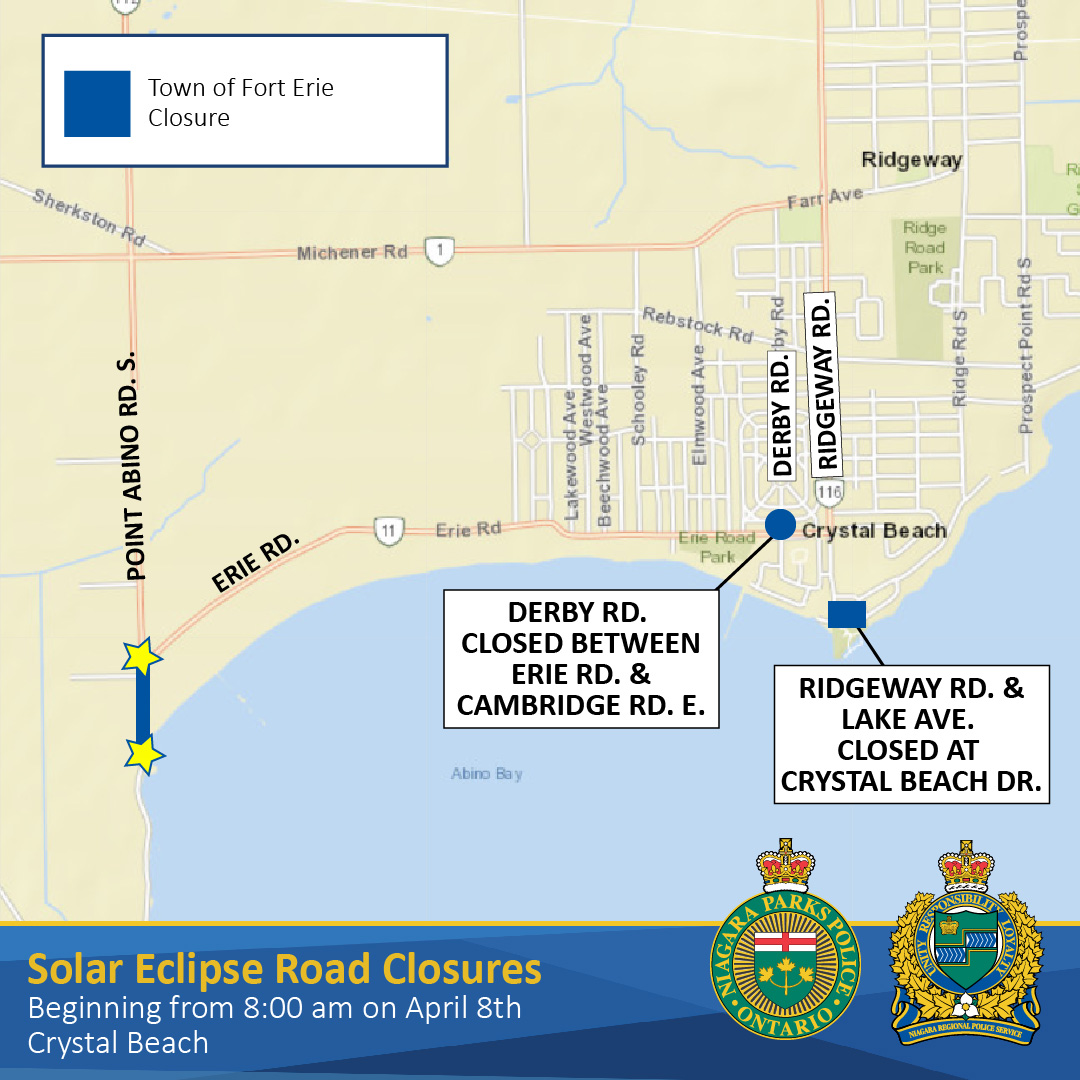
Welcome to Niagara - Once You Are Here
We asked visitors and residents to prepare for the day. Our request for being prepared does not stop once you get here.
|
To ensure a safe and enjoyable event we ask that residents and visitors consider the below tips:
|
|
Steer It and Clear It - Eclipse traffic is expected to be heavy with areas projected to see significant congestion. If you are involved in a collision, first assess if anyone is injured. If there are minimal injuries and the vehicles involved are drivable; clear the roadway to a safe spot so that traffic can continue to move. Report the collision to the proper authorities using the NRPS nonemergency number (905-688-4111) or 911 if needed.
Distracted Driving - Distracted driving continues to be a major safety factor on Ontario roadways. Distracted driving is the cause of hundreds of collisions across Niagara every year. Distracted driving, combined with congested roads and the eclipse event may compound problems on roadways in Niagara. The use of a handheld communication device while operating a motor vehicle in Ontario may result in a fine over $600.00 for a first offence.
Parking - Visitors to Niagara are reminded to park in designated parking spaces and be on the lookout for signage marking an area as prohibited parking. Motorists who park in prohibited areas or park in a way that causes an unsafe situation or further congestion may find their vehicle has been towed at their expense.
Patience - Traffic congestion in large crowds can cause frustration. We ask that visitors coming to the area pack their patience and be prepared for delays.
Bikes Locked Up - Active transportation such as riding a bike or walking can be a great way to get around traffic congestion related to motor vehicles. If you are bringing your bike to Niagara, we encourage you to ride safe, right defensively, be seen, wear a helmet, and secure your bike in a safe place when not in use e.g., hotel room.
Eye Safety - It is imperative when taking part in the eclipse event that you wear certified ISO safety glasses to protect your eyes when looking at the eclipse. Failing to do so could result in permanent eye damage. Pedestrian Safety – Pedestrians are requested to use caution when walking and to stay on the sidewalk. It is important to cross at designated crosswalks and intersections following the proper traffic signals.
Lost Family Members Prevention
Lock It or Lose It – It is important to leave your car locked with the windows up. Valuables should not be left in a vehicle but if you must they should be left out of sight or concealed.
Stay off the Rail – The historic safety guard rail that is along the Niagara River has kept millions of visitors safe for decades. Sitting or standing on top the guard rail is dangerous and increases the risk of falling or injury.
Reasons to Call 911 - For emergency assistance, dial 9-1-1 on your telephone. An operator will answer your call and determine what service is required. You will then be connected to either the police, fire, or ambulance service in your area. Please stay on the line until you are told to hang up. Let the operator control the conversation and answer all questions as best you can. In emergency situations, help is on the way as you are giving the information. A situation is where the safety of people or property is at risk. Examples of 9-1-1 emergencies include: a fire; crime in progress; or a medical crisis.
No People or Pets Left in Cars – Whether it be an overcast or sunny day, the interior of a car or van can heat up quickly placing a person or pet left inside at jeopardy. A vehicle with the window left ajar can still see deadly increases in the interior temperature. |
To contact a officers from the Niagara Regional Police Service Media Relations Unit email: mediainquiry@niagarapolice.ca
 I'd Like To
I'd Like To
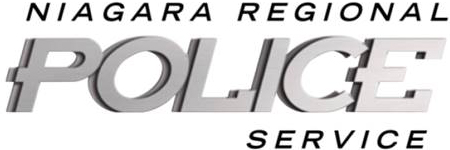




 Subscribe to this Page
Subscribe to this Page